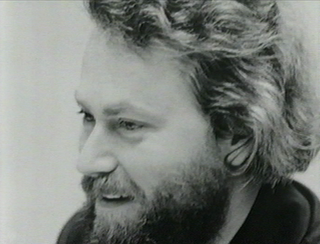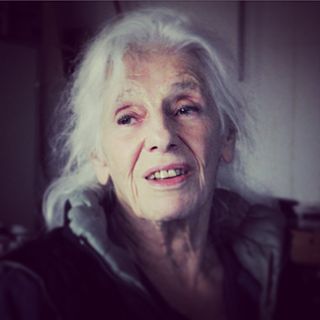Related Research Articles

Marfa is a city in the high desert of the Trans-Pecos in far West Texas, between the Davis Mountains and Big Bend National Park. It is the county seat of Presidio County, and its population as of the 2010 United States Census was 1,981. The city was founded in the early 1880s as a water stop; the population increased during World War II, but growth has stalled and reversed somewhat since the late 20th century. Today, Marfa is a tourist destination and a major center for minimalist art. Attractions include Building 98, the Chinati Foundation, artisan shops, historical architecture, a classic Texas town square, modern art installments, art galleries, and the Marfa lights.

Agnes Bernice Martin, was a Canadian born American abstract painter. Her work has been defined as an "essay in discretion on inward-ness and silence". Although she is often considered or referred to as a minimalist, Martin considered herself an abstract expressionist. She was awarded a National Medal of Arts from the National Endowment for the Arts in 1998. She was elected to the Royal Canadian Academy of Arts in 2004.

Dan Flavin was an American minimalist artist famous for creating sculptural objects and installations from commercially available fluorescent light fixtures.

Donald Clarence Judd was an American artist associated with minimalism. In his work, Judd sought autonomy and clarity for the constructed object and the space created by it, ultimately achieving a rigorously democratic presentation without compositional hierarchy. He is generally considered the leading international exponent of "minimalism," and its most important theoretician through such writings as "Specific Objects" (1964). Judd voiced his unorthodox perception of minimalism in Arts Yearbook 8, where he asserts; "The new three dimensional work doesn't constitute a movement, school, or style. The common aspects are too general and too little common to define a movement. The differences are greater than the similarities."

Robert W. Irwin is an American installation artist who has explored perception and the conditional in art, often through site-specific, architectural interventions that alter the physical, sensory and temporal experience of space.

Dia Art Foundation is a nonprofit organization that initiates, supports, presents, and preserves art projects. It was established in 1974 by Philippa de Menil, the daughter of Houston arts patron Dominique de Menil and an heiress to the Schlumberger oil exploration fortune; art dealer Heiner Friedrich, Philippa's husband; and Helen Winkler, a Houston art historian. Dia provides support to projects "whose nature or scale would preclude other funding sources."

John Angus Chamberlain was an American sculptor. At the time of his death he resided and worked on Shelter Island, New York.

Fort D. A. Russell is the name of an American military installation near Marfa, Texas, that was active from 1911 to 1946. Its namesake is David Allen Russell, a Civil War general killed at the Battle of Opequon, September 19, 1864.

The Menil Collection, located in Houston, Texas, refers either to a museum that houses the art collection of founders John de Menil and Dominique de Menil, or to the collection itself of approximately 17,000 paintings, sculptures, prints, drawings, photographs and rare books.
Dia Beacon is the museum for the Dia Art Foundation's collection of art from the 1960s to the present and is one of the 11 locations and sites they manage. The museum, which opened in 2003, is situated on the banks of the Hudson River in Beacon, New York. Dia Beacon's facility, the Riggio Galleries, is a former Nabisco box-printing facility that was renovated by Dia with artist Robert Irwin and architects Alan Koch, Lyn Rice, Galia Solomonoff, and Linda Taalman, then of OpenOffice. Along with Dia's permanent collection, Dia Beacon also presents temporary exhibitions, as well as public programs designed to complement the collection and exhibitions, including monthly Gallery Talks, Merce Cunningham Dance Company Events, Community Free Days for neighboring counties, and an education program that serves area students at all levels. With 160,000 square feet (15,000 m2), it is one of the largest exhibition spaces in the country for modern and contemporary art.

Dominique de Menil was a French-American art collector, philanthropist, founder of the Menil Collection and an heiress to the Schlumberger Limited oil-equipment fortune. She was awarded the National Medal of Arts in 1986.

The Chinati Foundation/La Fundación Chinati is a contemporary art museum located in Marfa, Texas, and based upon the ideas of its founder, artist Donald Judd.

Josephine Gail Baer is an American painter associated with minimalist art. She began exhibiting her work at the Fischbach Gallery, New York, and other venues for contemporary art in the mid-1960s. In the mid-1970s, she turned away from non-objective painting. Since then, Baer has fused images, symbols, words, and phrases in a non-narrative manner, a mode of expression she once termed "radical figuration." She currently lives and works in Amsterdam, Netherlands.
Paul Lee is a British artist based in New York City, United States.

Primary Structures: Younger American and British Sculptors was an exhibition presented by the Jewish Museum in New York City from April 27 to June 12, 1966. The show was a survey of recent work in sculpture by artists from the Northeast United States, California and Great Britain that shared general characteristics of scale, simplified geometry and smooth, often colorful, industrial surfaces. Its legacy, which focuses on a subset of the artists in the show, is as the exhibition that introduced Minimal Art to a broad public, both through the exhibition itself, and the wide attention it received in national media. Primary Structures was organized by Kynaston McShine, the Jewish Museum's Curator of Painting and Sculpture.

Minimalism describes movements in various forms of art and design, especially visual art and music, where the work is set out to expose the essence, essentials or identity of a subject through eliminating all non-essential forms, features or concepts. As a specific movement in the arts it is identified with developments in post–World War II Western Art, most strongly with American visual arts in the 1960s and early 1970s. Prominent artists associated with this movement include Ad Reinhardt, Nassos Daphnis, Tony Smith, Donald Judd, John McCracken, Agnes Martin, Dan Flavin, Robert Morris, Larry Bell, Anne Truitt, Yves Klein and Frank Stella. Artists themselves have sometimes reacted against the label due to the negative implication of the work being simplistic. Minimalism is often interpreted as a reaction to abstract expressionism and a bridge to postminimal art practices.
Heiner Friedrich is an art dealer and collector of minimal art and conceptual art. Friedrich and his then wife Philippa de Menil, together with Helen Winkler, established the Dia Art Foundation in 1973. Friedrich has exhibited works by Blinky Palermo, Walter De Maria, Donald Judd, La Monte Young, Andy Warhol, Michael Heizer, and Joseph Beuys, among others in his galleries in Germany, but became less interested in short term gallery installations and through Dia began to collect, and support major projects, such as Walter De Maria's The Lightning Field (1977) in New Mexico and purchasing a former military base in Marfa, Texas to enable Donald Judd to create a permanent space for the installation of his large minimal sculptures.

Donald Judd's progression sculptures are a series of wall sculptures created between 1964 and the 1970s. Each work is similar in form, with Judd's choice of material varying depending on the date of production. Judd based each work on a simple mathematical sequence such as the Fibonacci Sequence. He typically called the works Untitled, sometimes adding the word progression to the title. Judd, along with fellow artists, Dan Flavin and Mel Bochner, was interested in the minimalist notion of seriality or serial progression rather than the more classical relational method of composition.
Dia Bridgehampton, previously known as the Dan Flavin Art Institute, is a museum in Bridgehampton, New York, opened in 1983 and run by the Dia Art Foundation. The museum houses nine fluorescent light works by Dan Flavin on permanent display, a gallery for temporary exhibitions, and a display on the history of the building. It is one of the locations and sites the Dia Art Foundation manages.
References
- ↑ Govan and Bell, Dan Flavin: A Retrospective, Yale University Press, 2004
- ↑ diacenter.org accessed June 6, 2008
- ↑ Heartney, Eleanor. "Introductory Essay" (PDF). General Services Administration.
- ↑ Carol Vogel (February 13, 2004), National Gallery Adds to Collection New York Times .
- ↑ "untitled (to Helga and Carlo, with respect and affection)". Smithsonian. Smithsonian Institution. Archived from the original on 10 April 2022. Retrieved 10 April 2022.
- ↑ ""Piet Mondrian – Barnett Newman – Dan Flavin", Kunstmuseum Basel, 2013". Archived from the original on 19 August 2014. Retrieved 17 August 2014.
- ↑ Dan Flavin, untitled (Marfa project) (1996) Chinati Foundation, Marfa.
- ↑ "Dan Flavin", brochure, S. Maria in Chiesa Rossa, Fondazione Prada, Dia Center for the Arts, 1997. Essay by Michael Govan.